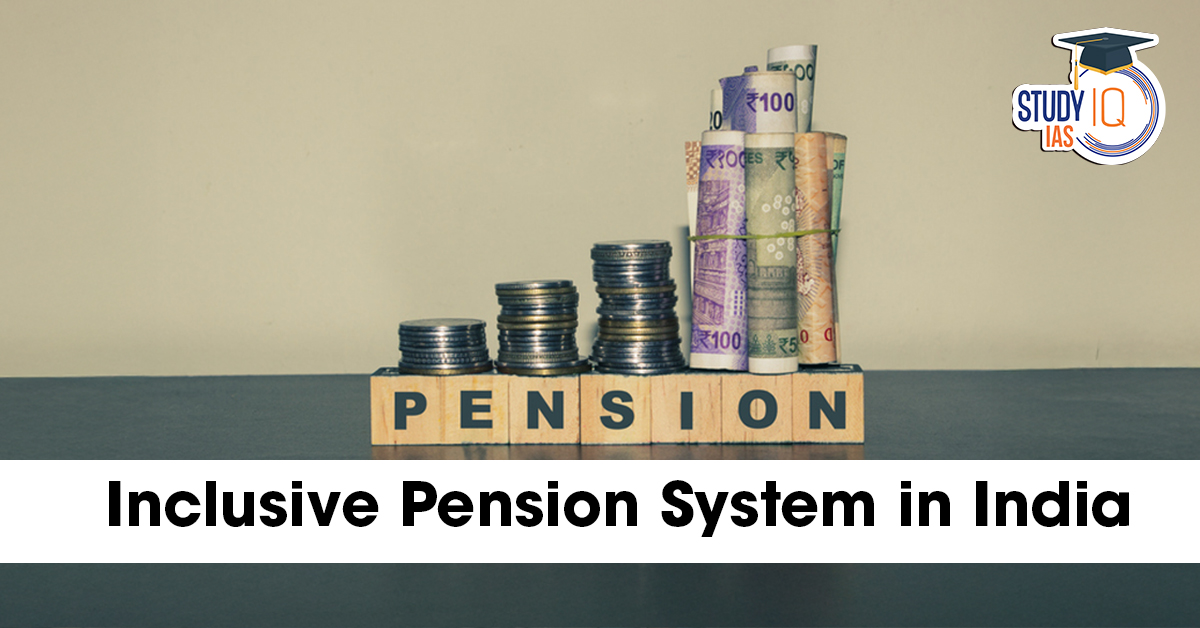Table of Contents
Context: Pensions offer financial security in retirement, particularly as income streams cease, healthcare costs rise, and inflation increases. In India, most retirees lack adequate pension coverage, making them vulnerable to poverty in old age.
Current Situation of Inclusive Pension System in India
- Pension assets = only 17% of GDP (vs. 80% in developed countries)
- Only 12% of India’s workforce is covered by formal pensions
- 85% of India’s workforce is in the informal sector, which is largely uncovered
- Atal Pension Yojana and National Pension System (NPS) (voluntary schemes) cover only 3% of the population.
What Are The Key Challenges?
- Fragmentation of Schemes: India has multiple, uncoordinated pension schemes run by different agencies (e.g., EPFO, NPS, Atal Pension Yojana, various state government schemes). This leads to overlap, inefficiencies, and confusion.
- Example: A gig worker might not know whether to enroll in the Atal Pension Yojana (run by PFRDA) or wait for a platform aggregator to contribute on their behalf under the Code on Social Security. This fragmentation reduces effective coverage and creates administrative hurdles.
- Low Coverage in Informal Sector: Only around 12% of the workforce is covered under formal pension systems. The informal sector, which accounts for 85% of the workforce, remains largely unregulated.
- Example: A street vendor or daily-wage labourer typically has no pension coverage unless they voluntarily join NPS or APY — but most don’t due to lack of awareness or resources.
- Lack of Awareness & Financial Literacy: Many informal workers are unaware of pension products or how to enroll. Literacy and trust in formal financial systems remain low, especially in rural and semi-urban India.
- Example: In a survey conducted among rural workers in Uttar Pradesh, fewer than 20% had heard of Atal Pension Yojana, and only 4% had enrolled.
- Inadequate Pension Adequacy: Even among those enrolled, the pension amounts are too low to provide meaningful financial security in old age.
- Example: Atal Pension Yojana offers a maximum pension of ₹5,000/month, which is insufficient to meet basic living and medical costs for retirees in urban areas.
- India scored only 44% on the Mercer CFA Global Pension Index 2024, with a poor rating on adequacy.
- Sustainability and Liquidity Concerns: Many pension funds, especially public ones, face financial strain due to increasing payouts and fewer contributors.
- Example: China is struggling to sustain its public pension fund due to an ageing population and a low contribution base. India, with its rising old-age dependency ratio (projected at 30% by 2050), could face a similar crisis unless reforms are undertaken.
- Scalability and Infrastructure Barriers: Current pension platforms and delivery systems are not designed to handle mass inclusion, especially for gig workers, self-employed individuals, and rural populations.
- Example: Despite growth in platforms like Swiggy and Ola, few gig workers are enrolled in formal pensions due to unclear aggregator responsibilities and the lack of digital onboarding mechanisms.
- Voluntary Nature of Informal Sector Schemes: Schemes like NPS and APY are voluntary, which results in low uptake among low-income and informal workers.
Way Forward for India’s Pension Reforms
- Create a Unified, Tiered Pension Framework: Integrate all existing pension schemes (EPFO, NPS, APY, etc.) under a three-tiered national framework with a single regulatory authority.
- Structure:
- Tier 1: Mandatory flat-rate pension for all (basic security)
- Tier 2: Employer-based occupational pension (auto-enrollment or mandatory)
- Tier 3: Voluntary personal pension savings (incentivised by tax breaks)
- Structure:
- Expand Coverage to Informal and Gig Workers: Use digital platforms for enrolment and tracking.
- Ensure that aggregators/platforms under the gig economy contribute to worker pensions as mandated under the Social Security Code
- Offer co-contribution schemes from the government for low-income workers
- Improve Financial Literacy and Awareness: Integrate retirement planning and financial literacy into school and college curricula.
- Conduct mass media campaigns and grassroots outreach (via panchayats, SHGs, etc.)
- Create pension calculators and mobile apps in regional languages
- Ensure Financial Sustainability of Pension Funds: Diversify pension fund investments into targeted debt, equities, and infrastructure bonds
- Introduce risk-based fund management with safeguards for the poor/elderly
- Encourage private pension fund participation for long-term viability
- Increase Trust and Transparency: Mandate annual pension entitlement disclosures.
- Use Aadhaar-based digital dashboards to allow individuals to track their contributions and expected payouts.
- Leverage Technology for Scale: Adopt mobile-based KYC, digital onboarding, and grievance redressal.
- Expand Jan Dhan–Aadhaar–Mobile (JAM) infrastructure to facilitate direct benefit transfer for pensions.
- Use India Stack to build a pension stack akin to the health stack model
Global Best Practices India Can Emulate
| Country | Practice | Details |
| Japan | Mandatory national pension | Every resident (20–59 yrs), including informal/self-employed, contributes to a basic pension |
| New Zealand | Universal public pension | Flat-rate pension for everyone aged 65+, subject to 10-year residency |
| United Kingdom | Auto-enrollment (“opt-out”) | Employees are automatically enrolled in pension plans; they must opt out actively if they don’t want it |
| Netherlands | Transparent disclosures | Pension funds send yearly statements to all contributors, boosting trust |
| Australia | Financial education in the curriculum | Superannuation and retirement savings are taught in schools to build early awareness |
| Nigeria | Digital pension outreach | Used digital tools and apps to reach informal workers and boost pension enrolment rates |
| Denmark / Netherlands | Public-private partnership | Strong private pension funds supplement the state pension; focus on sustainability and stable returns |
| United States | Diversified pension investments | Pension funds invest in debt, equity, and infrastructure to ensure stable long-term returns |


 Out-of-Pocket Health Expenditure, Reason...
Out-of-Pocket Health Expenditure, Reason...
 Treasury Bills (T-bills): RBI Cuts Holdi...
Treasury Bills (T-bills): RBI Cuts Holdi...
 Fisheries Sector in India, Current Statu...
Fisheries Sector in India, Current Statu...

























